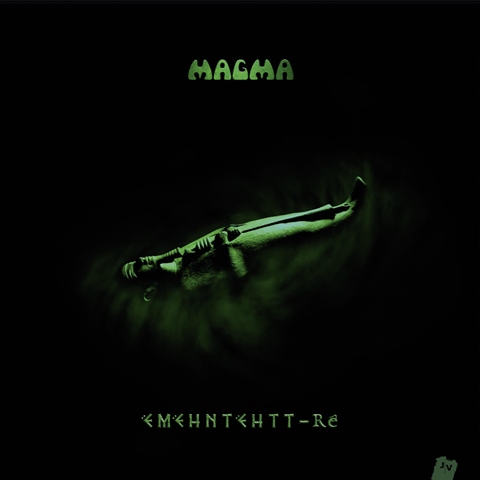 Magma: Köhntarkösz, Köhntarkösz Anteria, Ëmëhntëhtt-Ré
Magma: Köhntarkösz, Köhntarkösz Anteria, Ëmëhntëhtt-Ré
“They were a Seventies phenomenon,” said snooker ace Steve Davies of Magma. “But they were a bit too far out there for most people, even if you liked progressive music. I didn't dare put them on the communal record player at sixth-form because they would have been booed off. Maybe it's because they were French.”
Magma – the band Davies declared his “true obsession” – are still going strong under the guidance of their visionary drummer Christian Vander. John Lydon was another fan. The vinyl-only reissue of three of their albums, 1974’s Köhntarkösz, 2004’s Köhntarkösz Anteria and 2009’s Ëmëhntëhtt-Ré, is accompanied by a new release, Rïah Sahïltaahk – an album reconfiguring material from their 1971 album 1001 Degrés Centigrades.
Köhntarkösz, Köhntarkösz Anteria and Ëmëhntëhtt-Ré were a thematically inter-related trilogy exploring the understanding of the nature of the universe, focussing on the quest for meaning undertaken by the pharaoh Ëmëhntëhtt-Ré. Ëmëhntëhtt-Ré the album revisits musical themes and tracks from three other previous Magma albums, restructuring them into a suite.
 A self-referencing and self-defining continuum, Magma are also, as Davies acknowledged, a challenging listen. Vander’s devotion to John Coltrane drives the band. They are not rock, jazz-rock or even fusion, but a unit fashioned to deliver a hard-edged music which never stands still. With the force of metal, nothing is dispensed straightforwardly. Compositions present themes, develop them and then layer on new themes while still pursuing their original path. Although formalist, this music is never linear. Improvisation is accommodated, but only within a rigid structure.
A self-referencing and self-defining continuum, Magma are also, as Davies acknowledged, a challenging listen. Vander’s devotion to John Coltrane drives the band. They are not rock, jazz-rock or even fusion, but a unit fashioned to deliver a hard-edged music which never stands still. With the force of metal, nothing is dispensed straightforwardly. Compositions present themes, develop them and then layer on new themes while still pursuing their original path. Although formalist, this music is never linear. Improvisation is accommodated, but only within a rigid structure.
The challenge is made even tougher by their lyrics being in Kobaïan, a Germanic-sounding language devised by Vander. He thought French would not suit this music. The mythology of the planet Kobaïa – settled by people who have fled a doomed Earth – dominates all Magma’s music. The conflicts, mythos, preoccupations and travails of the settler’s descendants – the Kobaïans – are documented in Magma’s apocalyptic music.
Of such stuff, a cult is made. And for the members of Magma, their black garb and the donning of the massive Kobaïan pendant brings the unified, quasi-military look of cult members. From all perspectives, Magma are a daunting proposition.
 When it comes to the music, Magma generally demand intense brow furrowing. They are not fun.The entry point here, and the essential one of these three reissues, is Köhntarkösz. The album begins with the 15-minute “Köhntarkösz part 1” which initially sounds like a percussion-heavy marriage of the breakdown section of an Emerson, Lake & Palmer workout and early King Crimson. Then, an operatic male voice begins intoning. Around three minutes in, it goes a bit twinkly but retains the percussive heaviness. Carl Orff and Soft Machine are in there as is, inevitably, Coltrane (the album’s final track is titled “Coltrane Sündïa”). If the British jazz-prog band Colosseum had developed a fondness for opera and a sore head, it would approach this. Unlike a lot of music from the progressive era, this was about creating impact rather than showcasing aimless musical chops. There is tonal shading, but Magma were intent on setting an unsettling ambiance.
When it comes to the music, Magma generally demand intense brow furrowing. They are not fun.The entry point here, and the essential one of these three reissues, is Köhntarkösz. The album begins with the 15-minute “Köhntarkösz part 1” which initially sounds like a percussion-heavy marriage of the breakdown section of an Emerson, Lake & Palmer workout and early King Crimson. Then, an operatic male voice begins intoning. Around three minutes in, it goes a bit twinkly but retains the percussive heaviness. Carl Orff and Soft Machine are in there as is, inevitably, Coltrane (the album’s final track is titled “Coltrane Sündïa”). If the British jazz-prog band Colosseum had developed a fondness for opera and a sore head, it would approach this. Unlike a lot of music from the progressive era, this was about creating impact rather than showcasing aimless musical chops. There is tonal shading, but Magma were intent on setting an unsettling ambiance.
Each of the three reissues sounds amazing. Köhntarkösz is more immediate and much punchier than an original French pressing: as if a layer of aural Vaseline has been removed. The trio are the opening salvo in a campaign reissuing the entire Magma back catalogue over this year. Although probably for the already converted and perhaps jazz-inclined fans of the similarly apocalyptic Killing Joke, Magma are a unique entity and worth properly hearing at least once. A good point to try them out will come in May, when their classic third album Mëkanïk Dëstruktïẁ Kömmandöh is reissued.
Steve Davies memorably summed it up. “While I think they are the best thing I've ever heard – challenging, stimulating, powerful – my wife thinks they've got a pact with the devil. People generally just go: sorry!”















Add comment